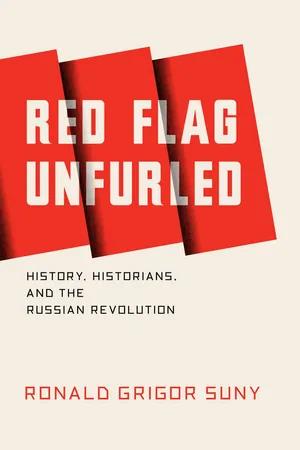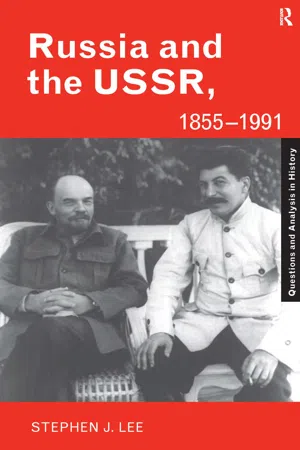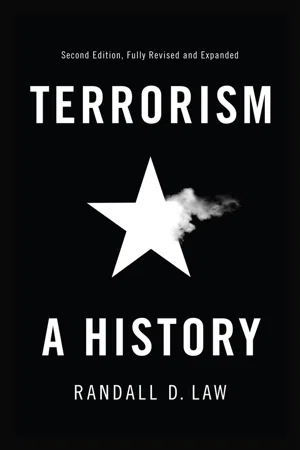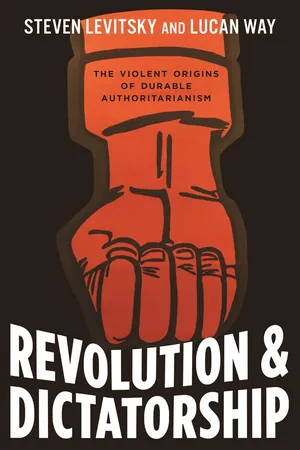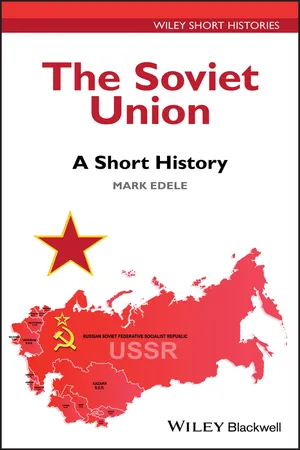History
Second White Terror
The Second White Terror refers to a period of political violence and repression in Taiwan that occurred in the 1940s and 1950s. It was characterized by the suppression of political dissidents, intellectuals, and anyone suspected of being a communist sympathizer by the ruling Kuomintang government. Thousands of people were arrested, imprisoned, and executed during this time.
Written by Perlego with AI-assistance
Related key terms
Related key terms
1 of 4
Related key terms
1 of 3
6 Key excerpts on "Second White Terror"
- eBook - ePub
Red Flag Unfurled
History, Historians, and the Russian Revolution
- Ronald Suny(Author)
- 2017(Publication Date)
- Verso(Publisher)
123 Red Terror was revolutionary; White Terror was conservative, restorative. But, as Joshua Sanborn points out,in the case of the Jews, we see not only the development of terror practices (like hostage-taking, decimation, mass retribution, mass deportation, rape, robbery, and sadistic, spectacularly cruel violence), but of the social intent. Most notably, efforts on the part of Ianushkevich’s Stavka to gather material on Jewish behavior in the army stressed that commanders were to gather this to prove all the “harm” that Jews posed to the army and to the nation. Given the tone and exclusionary fantasies of both prewar and wartime anti-Semitic discourse, we see in the Jewish terror a facet of White Terror that cannot simply be seen as a method of military dictatorship, a requirement of wartime emergency, or even the most brutal of counter-insurgency strategies. These were processes that were justified by the war atmosphere, but whose vision extended well into the post-war period. As a result, the White Terror, like the Imperial Army’s Terror campaign from 1914–1917, was revolutionary in its Terror against Jews, and who knows, might have taken this kernel even further had they prevailed in the Civil War.124Indeed, it is not simply by coincidence or accident that Red and White terror look alike, that both sides employed similarly horrific methods in their struggle to win the war and destroy the Other. The logic of civil war led both sides to use violence, not only in pitched battles of army against army, but also in their attempts to control populations in the absence of overwhelming force or positive support; to obtain information and prevent information reaching the enemy; to discourage defections, and to mobilize people to fight for their side and not for their enemies.The Costs of the Russian Civil WarsAlthough full figures for the extent of Red or White terror in the early years of Soviet Power are elusive, historians have given various estimates. Official Soviet accounts claim only about 13,000 killed by the Red Terror from 1918 to 1920, but Western historians have estimated between 50,000 and 140,000. Figures for the White terror are even more difficult to come by because the White forces fell under different administrations, and much of the violence on the anti-Bolshevik side was carried out by undisciplined forces operating independently of the more disciplined White forces. According to the best estimates, bands allied with Simon Petlura, who emerged as a major leader of independent Ukraine in 1918–19, committed 40 percent of anti-Jewish atrocities during the Civil War; another 25 percent were carried out by other Ukrainian forces; non-Ukrainian White armies, primarily Cossacks, were responsible for 17 percent; while units of the Red Army accounted for 8.5 percent. Estimates of Jews killed range from 35,000 to 150,000, with a shared consensus of about 50,000.125 - eBook - ePub
The White Terror
Antisemitic and Political Violence in Hungary, 1919-1921
- Béla Bodó(Author)
- 2019(Publication Date)
- Routledge(Publisher)
2The Hungarian interpretation of the Red and White Terrors closely mirrored the contemporary Italian and German narratives about their own civil wars; in both fascist Italy and interwar Germany, bourgeois commentators and the veterans of the militia movements habitually portrayed extralegal violence attributed to the arditi (Italian special forces during the First World War) and the German Freikorps as an understandable and mild reaction to Socialist and Communist crimes.3 The idea of right-wing political violence as a reaction to Communist atrocities did not die with the end of the Second World War, but found its way into the conservative liberal interpretation of fascism in the 1960s.4 Its last echoes could be detected in debates on the rise of Hitler, the place of Nazism in German and European history, and the behavior of German troops in the final phase of the Second World War during the Historikerstreit in the mid-1980s.5The left-wing interpretation of the civil war was in many respects the mirror image of the conservative and right radical narratives. Exiled Communist functionaries, such as József Pogány, defended the excesses committed by the Red militias as justifiable acts of self-defense. The White Terror, in his opinion, served a different purpose. The goal of the White paramilitary groups and the counterrevolutionary regime, Pogány argued, was to “exterminate the working class,” destroy its organizations, and turn the clock back on progressive social policy. The right-wing militias were the hirelings of the bourgeoisie and the elite, and “The Hungarian White Terror [wa]s nothing more than the dictatorship of the bourgeoisie. Its [specific] form [wa]s determined by the fact that the leaders of the dictatorship [we]re professional soldiers.”6 Already in 1923, Pogány’s comrade and the future Minister of Culture József Révai called this new type of regime fascist.7 Marxist scholars after 1945 identified the White Terror as the founding moment of European fascism and the “fascist” Horthy regime; as a prelude to the Second World War and Jewish genocide, and a model for the “counterrevolution” of 1956.8 - eBook - ePub
Russia and the USSR, 1855–1991
Autocracy and Dictatorship
- Stephen J. Lee(Author)
- 2020(Publication Date)
- Routledge(Publisher)
But there is an alternative – that it sprang from that authority’s losing the initiative in dealing with the problem of opposition in a more controlled and restrained way. To an extent terror can be seen as endemic to the Russian political and social condition, implicit in the tradition of reaction and revolution alike. It appeared in the reigns of Ivan the Terrible and Peter the Great, and reappeared in the pogroms of Alexander III and Nicholas II, the Red Terror of Lenin and the purges of Stalin. There is also a continuity between the late-Tsarist and Soviet secret police – the progression from the Third Section to the Okhrana and then, via the Cheka and OGPU, to the NKVD and the KGB. Sometimes the connection between Tsarist and Soviet periods was direct – the victims of the Okhrana became the operators of the Cheka. There is even a strong historic and cultural connection, with Stalin’s rehabilitation of Ivan the Terrible and the deliberate parallels between the Oprichniki and the NKVD. Yet, despite the continuity, the Soviet period does seem to have practised terror on a much larger scale than Tsarist Russia. Within the period covered by this book, the most intense periods of Tsarist terror seem to have occurred in the last two decades of the nineteenth century – under Alexander III and Nicholas II. Yet these paled into insignificance beside the terror of the Lenin and Stalin periods. Under Lenin, terror became a ‘cleansing’ process, supported by Trotsky as a means of accelerating the dictatorship of the proletariat. ‘We shall not’, said Trotsky, ‘enter the kingdom of socialism in white gloves on a polished floor.’ By contrast, Tsarist terror operated to remove perceived threats to the existing system, not as part of the baptism of fire for a new one. The Leninist terror was reactivated by Stalin and given a new twist to ensure personal dictatorship. Under Stalin, therefore, terror entered a phase of reaction while retaining a revolutionary impetus - No longer available |Learn more
Terrorism
A History
- Randall D. Law(Author)
- 2016(Publication Date)
- Polity(Publisher)
10 The Era of State TerrorJudged by the standards of the day, individual and small-group terrorism around the turn of the century in Russia, Europe, the United States, Ireland, India, and elsewhere seemed to have reached enormous proportions. But after 1914, two world wars, Nazi genocide, and the creation of totalitarian regimes reminded Europeans that states were still the primary sources of organized terror, violence, and death. In the Soviet Union alone, perhaps fifty million people died “unnatural deaths” in political purges, man-made famines, and war.1 The terror unleashed during these years left permanent marks on the maps and psyches of Europeans, marks that continue to exert great influence today.As for the history of terrorism, there are two principal lessons: that acts carried out by subversive groups provide a treasure trove of tactics and strategies that are as murderously useful to repressive regimes; and that a regime’s accusation of terrorism against its opponents can also be useful in manufacturing support and consensus.Russia’s revolutions
Despite the assassinations carried out by the Combat Organization and the random bombings of the anarchists, it was not terrorism that directly brought down the Russian Empire. That was accomplished in February 1917 by hungry protesters in St. Petersburg demonstrating against an incompetent government’s prosecution of a hopeless war, and by the soldiers and police who refused to fire on them. Theirs was a people’s revolution. Not so the Bolsheviks’ armed coup d’état eight months later against the Provisional Government, which led to a quick Russian exit from the war, the rapid construction of a one-party dictatorship, and the enactment of a radical socialist program.Lenin’s party had in theory rejected sub-state terrorism, following the pre-revolutionary line espoused by Leon Trotsky, who had denounced assassination and “individual terror” as futile and ahistorical. And yet the Bolsheviks bore the imprint of their predecessors: they practiced banditry and economic terrorism under the designation of “revolutionary expropriations”; preserved their underground movement thanks to the conspiratorial methods pioneered by the People’s Will and other groups; and walked in the footsteps of Nechaev, who plotted a revolution on behalf of but not by - eBook - ePub
Revolution and Dictatorship
The Violent Origins of Durable Authoritarianism
- Steven Levitsky, Lucan Way(Authors)
- 2022(Publication Date)
- Princeton University Press(Publisher)
Since 1917, the government had been focused on eliminating counterrevolutionary threats from the aristocracy, the bourgeoisie, capitalist states, and the peasantry. Now, it suddenly became obsessed with finding and exterminating enemies within the party-state. In the process, the Bolsheviks nearly committed suicide. 224 The Great Terror resulted in roughly 2.5 million arrests and over 800,000 killings in 1937–1938. 225 During this period, Soviet authorities executed more than 1,000 people every day. 226 While most of those killed were common citizens, a substantial portion were longtime supporters of Stalin and “old Bolsheviks” who had worked with Lenin to found the Soviet state. 227 There had not been anything like it since the Jacobins consumed themselves in the French Reign of Terror in 1794. The Soviet Union’s origins in revolutionary civil war explain both why such a terror was possible and why the regime survived such a major attack on the core institutions of the Bolshevik regime. The Kirov assassination took place in a hostile international environment. In the late 1920s, the Bolsheviks had seen foreign threats that in fact barely existed. But in the early 1930s, they were as real as they possibly could be. In Europe, the rabidly anticommunist Nazis seized power in 1933 and fascism began to take hold in countries throughout Europe. The raison d’ ê tre of these regimes was the destruction of communism. In July 1936, a military coup against the Spanish Second Republic sparked a brutal civil war that quickly turned into a proxy war between Communists and Fascists. And throughout all of this, Trotsky, exiled in Mexico, was gaining international fame by excoriating Stalin. Such challenges were amplified in the minds of Bolshevik leaders by a worldview grounded in fears of capitalist encirclement - eBook - ePub
The Soviet Union
A Short History
- Mark Edele(Author)
- 2018(Publication Date)
- Wiley-Blackwell(Publisher)
The first revolution from above (1928–1932) targeted the peasantry in particular, as well as other remnants of the old order. It was made up of three parallel processes: a “cultural revolution” (1928–1931), that attempted to destroy the old elites and their culture and replace them by “proletarian” alternatives; the economic revolution of the First Five‐Year Plan (1929–1932) that attempted to force the country into the industrial age; and a rural revolution in the form of forced collectivization (from 1929), which was meant to pulverize peasant resistance to the extraction of grain that was needed to pay for the building of new industries. The first revolution from above resulted in untold hardship, social and geographic dislocation of unprecedented scale, a growing archipelago of camps and special settlements (the “Gulag,” run by the successor of the Cheka, now called NKVD), plummeting living standards, terribly low consumption levels, an increasingly hierarchical society, and a disastrous famine in the period 1932 to 1933 that killed millions. But it also laid the groundwork for the country that would be able to withstand the German storm from 1941. If in the 1914 to 1917 it was the victory of the western Allies that ultimately saved the lands of the Russian Empire from German occupation, in 1941 to 1945 it was the Soviet Empire that saved Europe from the Nazis.It is harder to see any redeeming aspects in the second revolution from above (1937–1938), although it followed the same logic of turning the country into an armed camp headed by an undisputed dictator. This second revolution is better known as the “Great Terror” or the “Great Purges.” Stalin, whose faction had won the war against the peasantry, and who had forced the country into a strange kind of primitive industrialism, where underfed workers built tanks and airplanes but lived in dugouts and barracks, now turned his attention to eliminate opponents within. Some of these enemies were real, others imagined, but they all were supposed to be exterminated in order to unite the country in preparation for war.This perverse logic first focused on the Communist Party itself, a major tactical innovation, as until the mid‐1930s “terror” was something Bolsheviks did to their enemies, not to themselves. Soon, however, targets outside the party came back into focus, a shift of attention to the wider society accounting for the largest number of victims. These were defined either as social others, who were targeted in NKVD Order 00447 of July 1937 (former rich peasants, former Tsarist officials, White Army officers, and members of political parties other than the Bolsheviks, former peasant insurgents from civil war days, clergy, people who had lost their civil rights, criminals, beggars, and other “socially harmful elements”) or as national enemies (diaspora nationalities with potential links to foreign governments, such as Poles, Germans, Koreans, Latvians, or Finns). Finally, potential opponents in the military were executed in a bloody purge of the officer corps in 1937 and 1938, to prevent any possible attempt at “Bonapartism.”
Index pages curate the most relevant extracts from our library of academic textbooks. They’ve been created using an in-house natural language model (NLM), each adding context and meaning to key research topics.
Explore more topic indexes
Explore more topic indexes
1 of 6
Explore more topic indexes
1 of 4
